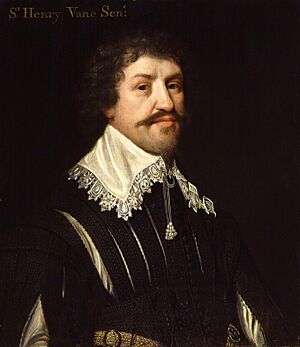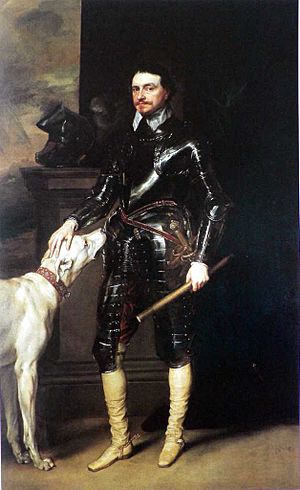Henry Vane the Elder facts for kids
Sir Henry Vane (born 1589, died 1655) was an important English politician. People called him the Elder to tell him apart from his son, who was also named Henry Vane.
Sir Henry Vane served King Charles I in many important jobs, like Secretary of State. But when the English Civil War started, he joined the Parliamentary side against the King.
Contents
Early Life and Education
Henry Vane was born in 1589. His family was from Hadlow, Kent.
He went to Brasenose College, Oxford, in 1604. Later, he studied law at Gray's Inn in 1606. In 1611, King James I made him a knight.
Rising in Politics
When he was 23, Henry Vane married Frances Darcy. Soon after, he started working at the royal court. He bought a job as a "carver" for the King, which cost a lot of money. He also bought a share in a legal office.
He became very good friends with King James I. The King even gave him control of the whole legal office for 40 years.
Working for Prince Charles
In 1617, Vane became the "cofferer" for Prince Charles. This meant he managed the Prince's money. When Charles became King, Vane kept this job. Around 1629, he became the "Comptroller of the Household," managing the King's home and staff. By 1639, he was the "Treasurer of the Household," another important role managing royal finances.
Vane was elected as a Member of Parliament (MP) several times, representing places like Lostwithiel and Carlisle. However, he didn't play a big part in the debates in Parliament at this time.
Diplomatic Missions
King Charles I sent Vane on important missions to other countries.
- In 1629 and 1630, he went to Holland to try and make peace between the Dutch and Spain.
- In 1631, he went to Germany to talk with Gustavus Adolphus of Sweden, a powerful king. King Charles wanted to form an alliance, but he only offered a small amount of money. Gustavus Adolphus refused the alliance.
Even though the alliances didn't happen, King Charles was happy with Vane's work. One official said Vane "saved his majesty's money and his honour."
Becoming a Trusted Advisor
Vane became a member of the Privy Council in 1630. These were the King's closest and most trusted advisors. He was considered part of the King's "cabinet," meaning he was in the inner circle.
He bought large estates, including Raby Castle in County Durham, which became his main home in the north. He spent a lot of money on land, and his wealth grew significantly.
In 1640, King Charles I made Vane Secretary of State. This was a very important job, and it happened because the Queen supported him.
Disagreement with Strafford
Sir Henry Vane had been friends with Lord Strafford, another powerful figure. However, they disagreed about how to handle the war with Scotland.
Their friendship ended when Strafford chose "Baron Raby" as one of his titles in 1640. Raby Castle belonged to Vane, and Vane had hoped to use that title himself. This made Vane very angry. Some historians believe this personal insult led to Strafford's downfall.
The Short Parliament
In April 1640, Vane was elected MP for Wilton in the Short Parliament. The King asked Parliament for money to fight the Scots. Vane told Parliament that the King would give up "ship-money" (a tax) if they gave him a large amount of money in return. Parliament refused, and the King dissolved Parliament quickly on May 5.
Some people blamed Vane for the Parliament's quick end, saying he made the situation worse. However, Vane was likely just following the King's orders. The King continued to trust him as Secretary of State.
Strafford's Trial
Vane played a key role in Strafford's trial. He testified that Strafford had advised the King to use an army from Ireland to control "this kingdom." The prosecution argued "this kingdom" meant England, not Scotland, which was a serious charge.
Vane said he had notes from the meeting where Strafford said these words. His son, Henry Vane the Younger, later gave a copy of these notes to John Pym, a leader of Parliament. This evidence was very important in the trial. Vane seemed very angry with his son for sharing the notes, but some people thought it was an act.
Dismissal by the King
Vane believed that Strafford's punishment would bring peace between the King and the people. However, his own time serving the King was ending.
In November 1641, King Charles I dismissed Vane from his job as Secretary of State and all other court positions. People at the time noted that Vane was "neither loved nor pitied of any man," and the King believed he had been disloyal.
Joining Parliament
After being dismissed, Vane quickly joined the Parliamentary side. In December 1641, his name was added to an important committee for Irish affairs. In 1642, Parliament named him lord lieutenant of Durham.
When the Civil War began, Durham was mostly loyal to the King. Vane couldn't truly control the area until Parliament won it back in 1644. Vane was a member of the Committee of Both Kingdoms, which helped manage the war effort.
Vane suffered great losses during the war. His home, Raby Castle, was taken by Royalist forces three times. He estimated his losses from damage and stolen goods were at least £16,000.
Vane remained in Parliament after the war. He died around May 1655, at about 66 years old. His wife, Frances, died in 1663.
Family
Sir Henry Vane and his wife Frances had several children:
- Sir Henry Vane the Younger (1613–1662) was a famous Puritan statesman. He was a governor of Massachusetts and a key leader in the Long Parliament.
- George Vane (born 1618) was knighted in 1640. He served as the High Sheriff of Durham for Parliament.
- Charles Vane went to Magdalen College, Oxford. He later became an agent for the Commonwealth (the government after the King) in Lisbon, Portugal.
- William Vane was a soldier who served in the Dutch army.
- Walter Vane was also a soldier in the Dutch army. He later worked for King Charles II and was killed in battle in 1674.
- Margaret married Sir Thomas Pelham, 2nd Baronet.
- Frances married Sir Robert Honywood.
- Anne married Sir Thomas Liddell.
- Elizabeth married Sir Francis Vincent.
In Fiction
Sir Henry Vane appears in a series of books called 1632 Series. In these stories, which imagine a different past, King Charles reads about Vane's future. Vane then escapes England and works with Strafford in a government-in-exile. Even though the original reasons for their fight haven't happened, Vane still acts like he's rivals with Strafford.
Images for kids





